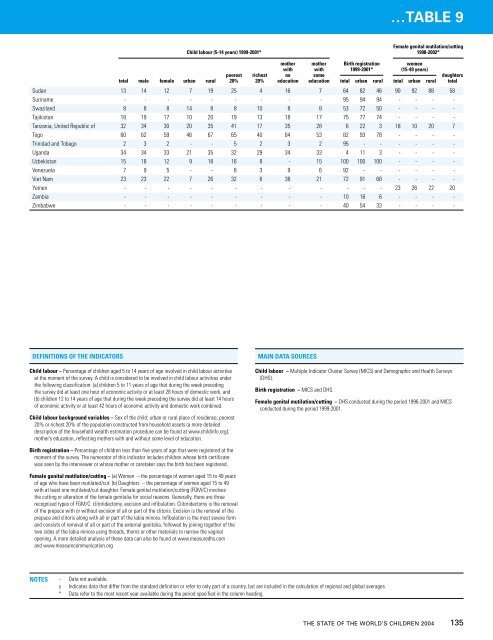THE STATE OF THE WORLD'S CHILDREN 2004 - Unicef
THE STATE OF THE WORLD'S CHILDREN 2004 - Unicef
THE STATE OF THE WORLD'S CHILDREN 2004 - Unicef
Create successful ePaper yourself
Turn your PDF publications into a flip-book with our unique Google optimized e-Paper software.
…TABLE 9<br />
Child labour (5-14 years) 1999-2001*<br />
Female genital mutilation/cutting<br />
1998-2002*<br />
total<br />
male<br />
female<br />
urban<br />
rural<br />
poorest<br />
20%<br />
women<br />
(15-49 years)<br />
Sudan 13 14 12 7 19 25 4 16 7 64 82 46 90 92 88 58<br />
Suriname - - - - - - - - - 95 94 94 - - - -<br />
Swaziland 8 8 8 14 8 8 10 8 8 53 72 50 - - - -<br />
Tajikistan 18 19 17 10 20 19 13 18 17 75 77 74 - - - -<br />
Tanzania, United Republic of 32 34 30 20 35 41 17 35 28 6 22 3 18 10 20 7<br />
Togo 60 62 59 46 67 65 40 64 53 82 93 78 - - - -<br />
Trinidad and Tobago 2 3 2 - - 5 2 3 2 95 - - - - - -<br />
Uganda 34 34 33 21 35 32 29 34 33 4 11 3 - - - -<br />
Uzbekistan 15 18 12 9 18 16 8 - 15 100 100 100 - - - -<br />
Venezuela 7 9 5 - - 8 3 9 6 92 - - - - - -<br />
Viet Nam 23 23 22 7 26 32 6 38 21 72 91 68 - - - -<br />
Yemen - - - - - - - - - - - - 23 26 22 20<br />
Zambia - - - - - - - - - 10 16 6 - - - -<br />
Zimbabwe - - - - - - - - - 40 54 33 - - - -<br />
richest<br />
20%<br />
mother<br />
with<br />
no<br />
education<br />
mother<br />
with<br />
some<br />
education<br />
Birth registration<br />
1999-2001*<br />
total<br />
urban<br />
rural<br />
total<br />
urban<br />
rural<br />
daughters<br />
total<br />
DEFINITIONS <strong>OF</strong> <strong>THE</strong> INDICATORS<br />
Child labour – Percentage of children aged 5 to 14 years of age involved in child labour activities<br />
at the moment of the survey. A child is considered to be involved in child labour activities under<br />
the following classification: (a) children 5 to 11 years of age that during the week preceding<br />
the survey did at least one hour of economic activity or at least 28 hours of domestic work, and<br />
(b) children 12 to 14 years of age that during the week preceding the survey did at least 14 hours<br />
of economic activity or at least 42 hours of economic activity and domestic work combined.<br />
Child labour background variables – Sex of the child; urban or rural place of residence; poorest<br />
20% or richest 20% of the population constructed from household assets (a more detailed<br />
description of the household wealth estimation procedure can be found at www.childinfo.org);<br />
mother’s education, reflecting mothers with and without some level of education.<br />
MAIN DATA SOURCES<br />
Child labour – Multiple Indicator Cluster Survey (MICS) and Demographic and Health Surveys<br />
(DHS).<br />
Birth registration – MICS and DHS.<br />
Female genital mutilation/cutting – DHS conducted during the period 1996-2001 and MICS<br />
conducted during the period 1999-2001.<br />
Birth registration – Percentage of children less than five years of age that were registered at the<br />
moment of the survey. The numerator of this indicator includes children whose birth certificate<br />
was seen by the interviewer or whose mother or caretaker says the birth has been registered.<br />
Female genital mutilation/cutting – (a) Women – the percentage of women aged 15 to 49 years<br />
of age who have been mutilated/cut. (b) Daughters – the percentage of women aged 15 to 49<br />
with at least one mutilated/cut daughter. Female genital mutilation/cutting (FGM/C) involves<br />
the cutting or alteration of the female genitalia for social reasons. Generally, there are three<br />
recognized types of FGM/C: clitoridectomy, excision and infibulation. Clitoridectomy is the removal<br />
of the prepuce with or without excision of all or part of the clitoris. Excision is the removal of the<br />
prepuce and clitoris along with all or part of the labia minora. Infibulation is the most severe form<br />
and consists of removal of all or part of the external genitalia, followed by joining together of the<br />
two sides of the labia minora using threads, thorns or other materials to narrow the vaginal<br />
opening. A more detailed analysis of these data can also be found at www.measuredhs.com<br />
and www.measurecommunication.org<br />
NOTES - Data not available.<br />
y Indicates data that differ from the standard definition or refer to only part of a country, but are included in the calculation of regional and global averages.<br />
* Data refer to the most recent year available during the period specified in the column heading.<br />
<strong>THE</strong> <strong>STATE</strong> <strong>OF</strong> <strong>THE</strong> WORLD’S <strong>CHILDREN</strong> <strong>2004</strong><br />
135
















